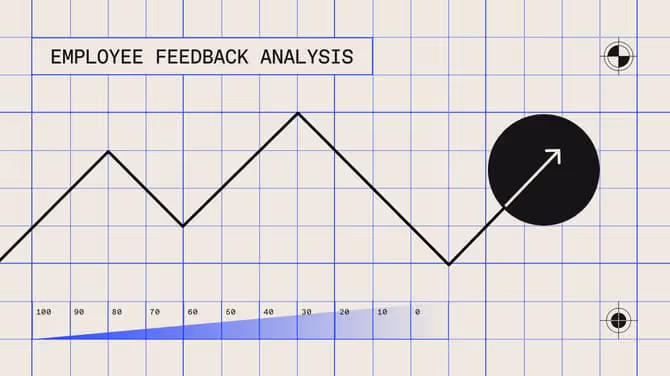Why conducting employee feedback analysis is so important

Discover Workleap Officevibe's benchmark report on 12 key employee engagement metrics

Employee feedback is more than just a collection of random comments and ratings from your team; it’s a gold mine of actionable insights. And when analyzed effectively, feedback becomes a powerful tool for making better decisions — be it to improve workplace culture or drive all-around success. Yet, many employers don’t leverage employee feedback to its full potential.
How an employee feels valued at work has a major impact on engagement and retention. As Gartner highlights, employees who feel valued are 27% less likely to quit. Factors include being informed, supported, considered, and acknowledged—which all boil down to mutual feedback (and putting it into action)! It's time to raise the bar on employee feedback analysis! Read on.
The importance of employee feedback: The good, the bad, and the opportunity
Feedback isn’t just a “nice-to-have” — it’s a “must-have” for any thriving organization. Effective feedback is crucial for employee development and organizational growth. It serves as a mirror, reflecting a company's strengths and weaknesses. After all, who’s better positioned to tell you what’s working (or not working) than those in the trenches?
Let’s check out some of the opportunities employee feedback can lead to.
Feedback loops encourage employee growth
Constructive feedback guides employees toward achieving their career goals, enhancing their skills, and becoming more well-rounded professionals. However, feedback conversations also provide opportunities for employees to express their needs so managers can better support them.
When companies create a true continuous feedback loop — it benefits both the employee and employer.
A feedback culture creates a positive work environment
When employee feedback is received and applied, it helps teams feel heard. The more collaborative a work environment is, the more everyone is engaged and motivated, which leads to higher productivity and job satisfaction.
{emphasize}
Two-way feedback says, “Hey, we’re in this together,” and that’s the kind of leadership vibe that people want to work for.
{emphasize}
Applying employee feedback retains top talent
Companies that implement regular feedback exhibit lower turnover rates than those that don’t. What does that tell us? Employees who feel their feedback is valued are more likely to stay with the company.
{emphasize}
High turnover can be costly and disruptive. Building feedback into the work culture can be a valuable retention tactic — your HR leaders will thank you!
{emphasize}
All in all, employee feedback (given or received) is very much a win-win.
Common challenges in collecting and analyzing feedback
So, the benefits of gathering employee feedback are obvious. Despite that, organizations still struggle with adequately collecting and analyzing it. What’s the deal? Let’s look at the most common challenges with feedback (and ways around them):
Low response rates to employee surveys
How does one collect feedback? Surveys! However, getting employees to participate in surveys can feel like herding cats. Lack of participation, survey fatigue, and a work culture that doesn’t value feedback can all contribute to low response rates.
{emphasize}
Make it easy and fun. User-friendly survey tools make answering surveys super simple and dynamic — through surprising prompts and gamification features. That should encourage higher participation rates.
{emphasize}
Biased feedback doesn’t provide an accurate picture
Feedback can be objective, but it can also be skewed by personal perspectives (subjective) or even fear of repercussions (sugar-coated). This can lead to collecting data that doesn’t quite represent a team's true sentiments or the office's realities.
{emphasize}
Encourage honest feedback with anonymous pulse surveys. Anonymity reassures employees that there will be no negative consequences for honest feedback — so they can feel comfortable being unfiltered (which is a good thing).
{emphasize}
Data overload
So, you’ve collected a large volume of feedback — now what? Without a clear strategy for analysis, all that info can be overwhelming. Many companies gather data but lack the tools and expertise to make sense of it.
Keep data organized with analytics tools. Feedback analysis tools can help you sort through the data efficiently. They offer advanced analytics and visualizations to make data interpretation that much easier.
Lack of follow-through
Failing to act on feedback can demoralize employees even when feedback is collected and analyzed. Managers must commit to closing the feedback loop by implementing changes based on the insights gained.
{emphasize}
Keep everyone accountable with action plans. Clear, actionable next steps after feedback let your team know that their feedback will lead to real change. This builds trust and reinforces the value of giving feedback.
{emphasize}
Benefits of effective employee feedback analysis
Employee feedback analysis sounds like a worthwhile investment, doesn’t it? When done correctly, the insights feedback analysis provides can completely transform an organization:
Feedback insights improve decision-making
Analyzing feedback provides insights that can guide strategic decisions. For example, gaining a true understanding of workload concerns can inform resource allocation and project planning.
Feedback-driven decisions are more likely to address real issues and needs than letting managers make decisions based on assumptions, and that leads to much better outcomes.
{emphasize}
There is beauty in diversity. Including other people in the conversations allows multiple perspectives on a task or problem at hand. That’s the beauty of pooling from a diversified workforce.
{emphasize}
Employee engagement gets a boost
Employees who see their feedback leading to real changes are more likely to be engaged… and engaged employees are more productive, committed, and willing to go the extra mile for your company!
Surveys made specifically for engagement. Speaking of employee engagement, read how employee engagement surveys can equip managers with mind-reading insights to better support their teams.
Training needs are made clear — and can be addressed
A feedback analysis can point out areas where employees need more support or training. Addressing these needs helps develop a more competent and confident workforce, which is the goal!
{emphasize}
Everyone is different. Tailored training programs based on feedback ensure each employee has the skills needed to succeed.
{emphasize}
Strengthening leadership
It’s a two-way street, right? Feedback can equally provide valuable insights into leadership effectiveness. Leaders who are open to feedback lead by example and improve their management approach by observing their teams.
{emphasize}
Remember management and leadership surveys. Here are 33 questions to ask your employees, covering everything from communication skills to trust and respect.
{emphasize}
Best practices for collecting employee feedback
To get the most out of employee feedback, it’s important to follow best practices in collecting it. The more accurate the data you gather, the easier it will be to analyze it and infer good insights.
Here are some tried-and-true tips:
Create a safe and anonymous environment
Employees need to feel safe when giving feedback. Managers can encourage more honest and constructive input from their teams by ensuring anonymity (when appropriate) and communicating how the feedback will be used.
Use diverse feedback channels — not just surveys
Yes, surveys are great but don’t rely solely on them. There are other ways to gather employee feedback—and they're more qualitative, too! Use one-on-one meetings, focus groups, and suggestion boxes to gather various perspectives in different formats.
Keep surveys short and focused
Long surveys can lead to fatigue and lower response rates from employees. If you manage to keep surveys concise and focused on specific topics, then it’s easier to maintain engagement around surveys — as well as implement them more regularly.
Communicate the purpose and intention of feedback collection
Leaving employees in the dark will invite reticence to participate in feedback giving. Managers build trust and encourage open communication by clearly explaining why feedback is being collected and how it will be used.
Regularly collect feedback
Skip the one-time event and make feedback a continuous process instead. Regular feedback collection tracks changes over time more efficiently than leaving large gaps of time between employee sentiment pulse checks. Regularity keeps employees engaged, too!
{highlight}
Vibe Check: The art of giving and receiving feedback
Looking for a deeper dive into feedback dynamics? Check out this Vibe Check episode on the art of giving and receiving feedback. It’s peppered with practical tips and real-world examples to help you enhance your own feedback culture!
{highlight}
Making feedback work for you: How to analyze employee survey results
Collecting employee feedback is only the first step. The real value lies in analyzing the survey findings to reveal opportunities for improvement (we call these actionable insights), which will inform any necessary next steps.
Tip #1. Categorize the feedback
Making sense of things starts with having a clear worktable (metaphorically speaking). Organize feedback into categories — it’ll help you identify patterns and areas that need the most attention.
You might notice many comments about "lack of communication" under the leadership category. Group these together to see the bigger picture.
Tip #2. Look for trends
Analyze feedback over time to spot trends with more accuracy. Are there recurring issues or improvements? Pay attention to those. Understanding patterns can guide long-term solutions.
If you see a consistent rise in complaints about work-life balance every quarter, it’s a trend worth investigating further.
Tip #3. Use quantitative and qualitative analysis
Combine quantitative data (like survey ratings) with qualitative insights (think open-ended comments) for a holistic view of things. A mixed-method approach provides depth and context!
Your survey might show an average rating of 3.2/5 for job satisfaction. Dig into the comments to find out why employees gave that rating.
Tip #4. Leverage technology
Technology can help automate and streamline feedback analysis. Feedback platforms offer advanced analytics and visualizations to make data interpretation easier and more effective.
Using dedicated tools to create visual reports that highlight key areas needing attention saves you time and effort.
Tip #5. Prioritize actionable insights
Not all feedback will be actionable, so focus on feedback that can lead to tangible improvements — prioritizing issues that have the greatest impact on employee performance or job satisfaction.
If employees frequently mention outdated software as a productivity blocker, prioritize upgrading your tools to improve overall efficiency.
Turning employee feedback into actionable insights: 5-step approach
The real magic of feedback lies in turning those insights into meaningful action. Let’s dive into how to make it happen:
Step 1. Develop an action plan
Feedback analysis done? Now, it's time to create an action plan. Think of it as the roadmap to success, outlining all the specific steps, who's in charge, and target milestones to keep things on track.
{emphasize}
Pro tip: Break it down into bite-sized tasks and assign each task to specific team members. This makes an action plan less overwhelming and keeps everyone on the same page.
{emphasize}
Step 2. Communicate changes with the team
Transparency is key. Based on their feedback, let your team know about the changes you’re making. This not only shows you value their input but also boosts morale because they know positive change is coming.
Pro tip: Use different communication channels, such as team meetings, email updates, and internal newsletters, to ensure everyone gets the memo. It’s all about keeping the team in the loop.
Step 3. Monitor progress and involve the team
Keep an eye on how things are going and regularly check if the changes are actually making a difference. Follow-up surveys can help you see if the action plan is on track and working.
{emphasize}
Pro tip: Stay on top of it with sophisticated project management tools to track progress. This way, you can make quick adjustments if needed without redoing your entire plan.
{emphasize}
Step 4. Celebrate the wins!
When things go well, celebrate those wins! Recognizing positive outcomes shows that feedback leads to real change and keeps the momentum going — and that’s something worth communicating.
Pro tip: To drive the point home, highlight specific examples of how feedback made a difference. This will encourage more employees to participate in future feedback because they understand the value, too.
Step 5. Iterate and improve constantly
Feedback isn’t a one-and-done deal — it’s more like a lifestyle. Keep the cycle going by continuously seeking input, analyzing results, and making improvements.
{emphasize}
Pro tip: Schedule regular review cycles, like every quarter, to go over feedback, assess what’s working, and identify new areas for improvement.
By following these steps and incorporating these pro tips, you can ensure that your organization effectively turns employee feedback into actionable insights, leading to sustained improvements and a more engaged workforce.
{emphasize}
Let's keep making those positive changes happen!
Amp up your employee feedback analysis game with software
Remember, it’s not just about collecting feedback — it’s about listening, understanding, and acting on it to build a better workplace for everyone. Effective employee feedback analysis is crucial for driving organizational success. By appreciating its value, applying best practices, and having a step-by-step process in place to analyze all that valuable survey data, you’ll be on the fast track to team improvement and growth.
Interested in transforming your feedback process? Workleap Officevibe offers cutting-edge tools to help you collect, analyze, and act on employee feedback effectively.
Give HR and managers the clarity, confidence, and connection to lead better every day.





.avif)
.avif)








